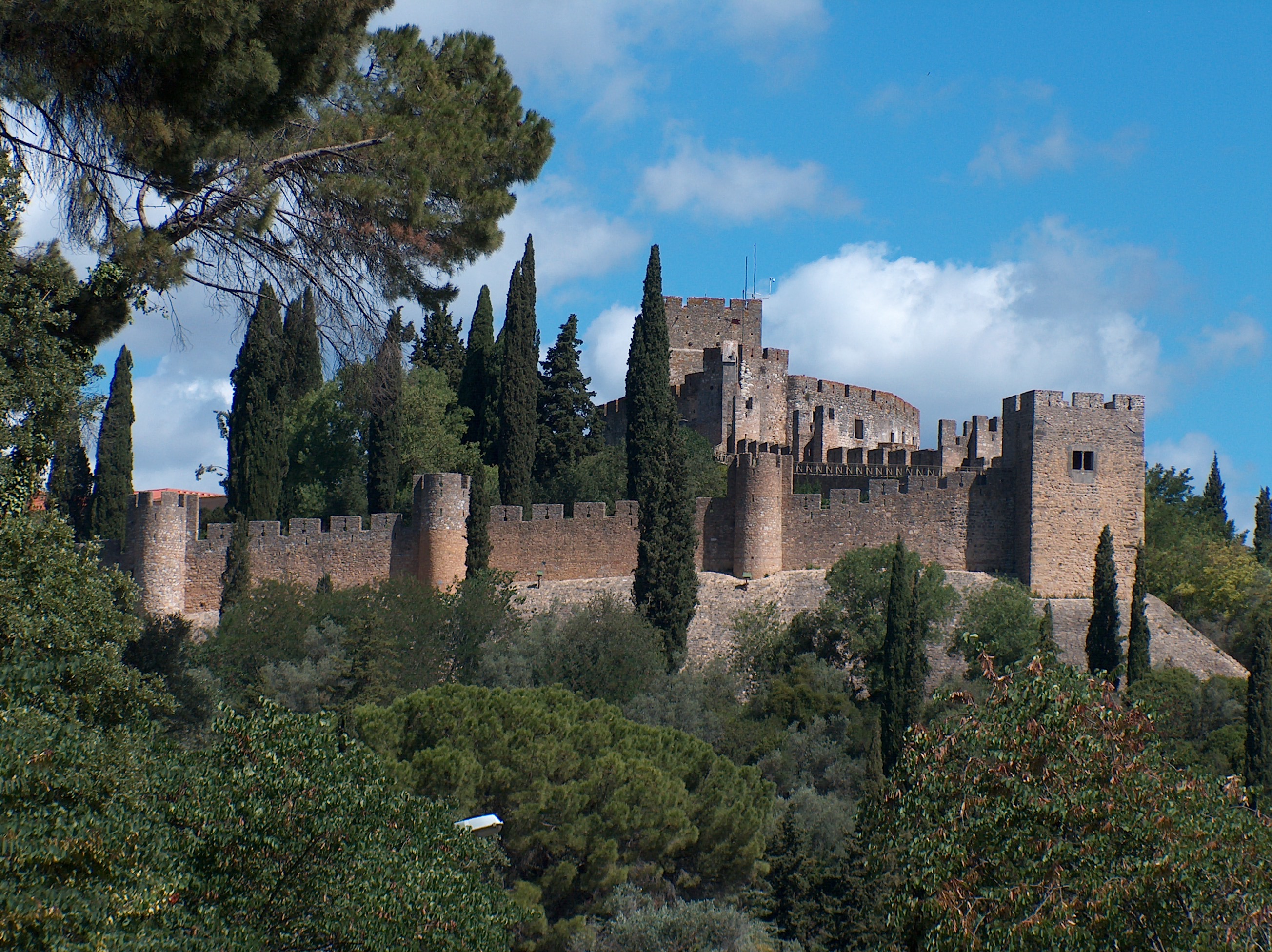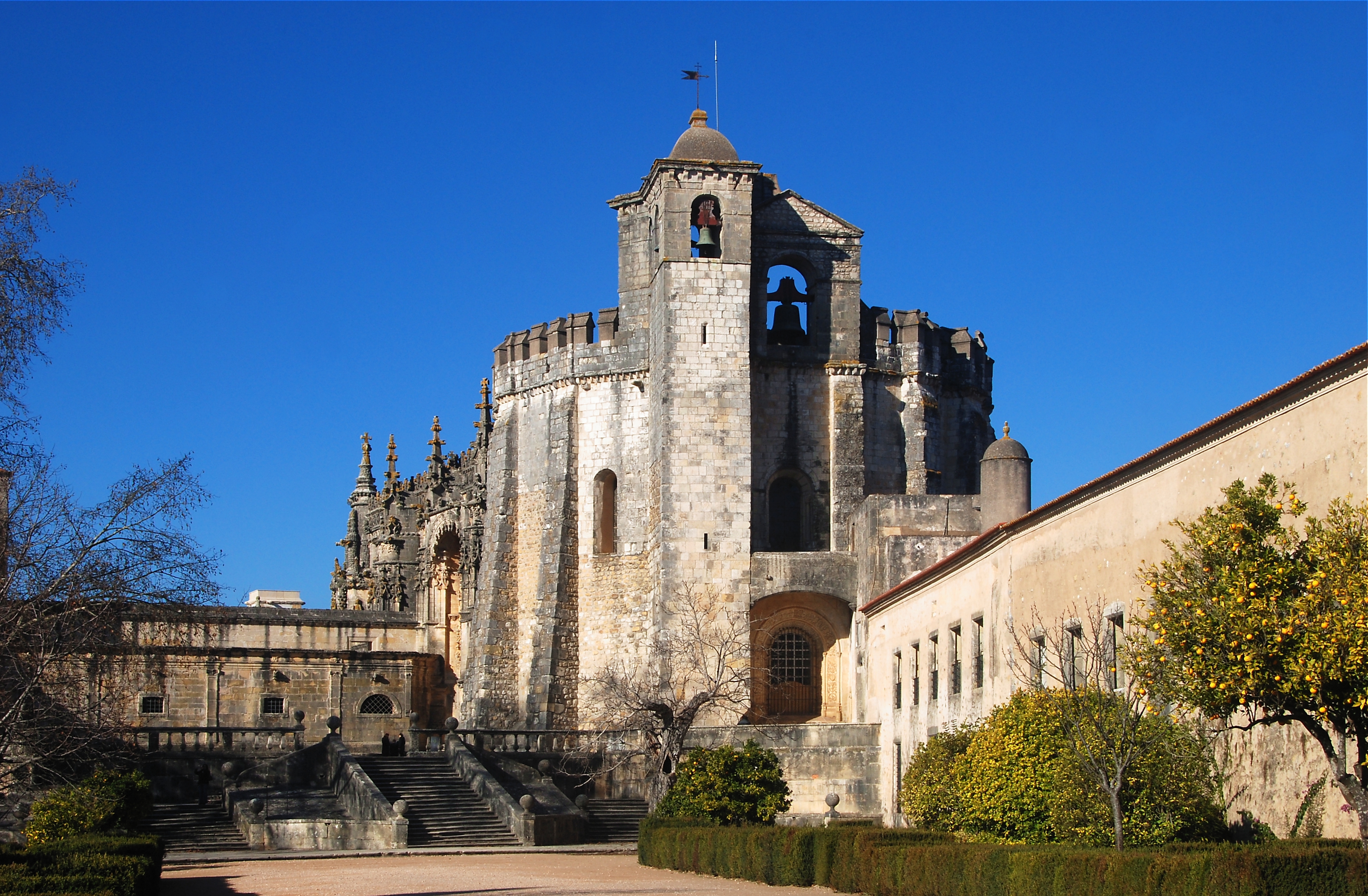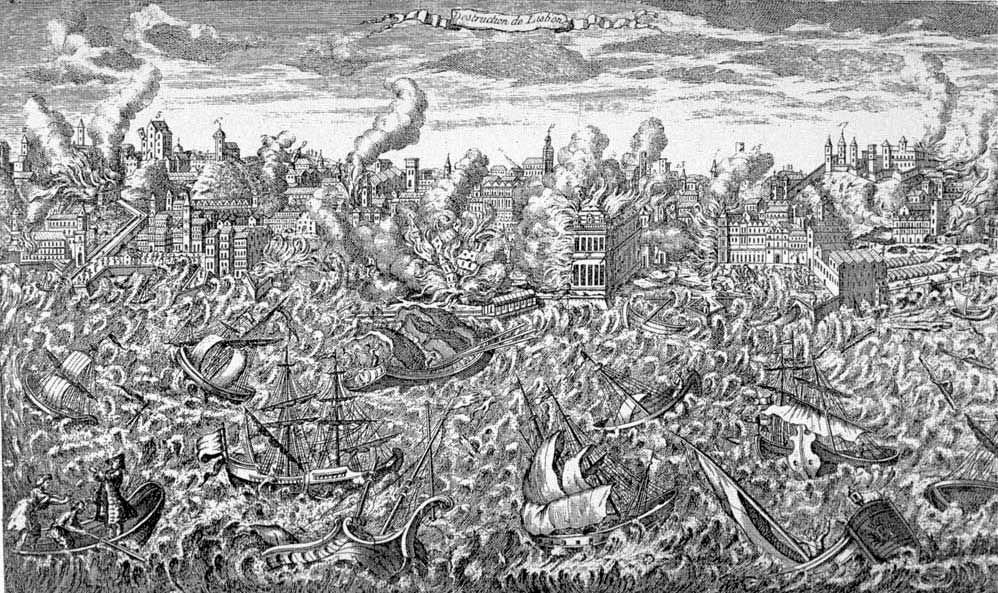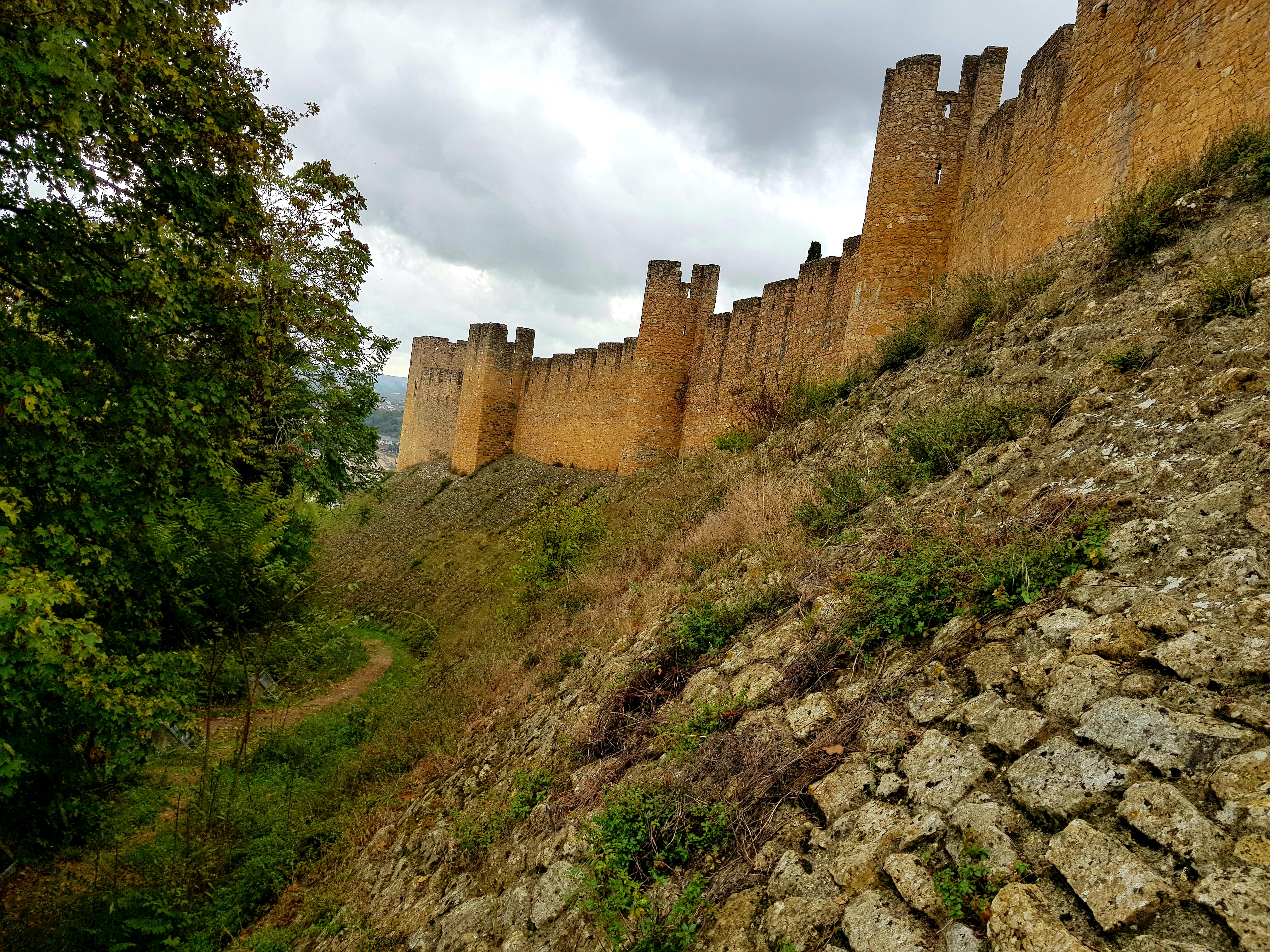|
Castle Of Tomar
Tomar Castle is a Monuments of Portugal, national monument in the Santarém District of Portugal. Built on a hill above the town of Tomar and the Nabão River, river Nabão on land donated by King Afonso Henriques it was the Portuguese headquarters of the Knights Templar and the residence of their Grand Prior or Preceptor. It subsequently belonged to their successors in Portugal, the Order of Christ (Portugal), Order of Christ, and later became part of the Convent of Christ (Tomar), Convento de Cristo, a catholic convent and UNESCO World Heritage Site. Architecture Built around 1160 as a Templar stronghold, it has an outer defensive wall and a citadel (''alcáçova'') with a keep inside. The keep, a central tower with residential and defensive functions, was introduced into Portugal by the Templars, and the example in Tomar is one of the oldest in the country. Another innovation introduced into Portugal by the Templars (learned from decades of experience in Normandy and Brittany ... [...More Info...] [...Related Items...] OR: [Wikipedia] [Google] [Baidu] |
Tomar Castelo 0244
Tomar (), also known in English as Thomar (the ancient name of Tomar), is a Portuguese city and a municipality in the historical Ribatejo Portuguese province, and in Santarém district. The town proper has a population of about 20,000. The municipality population in 2011 was 40,677, in an area of . The town of Tomar was created inside the walls of the Convento de Cristo, constructed under the orders of Gualdim de Pais, the fourth Grand Master of the Knights Templar in Portugal in the late 12th century. Tomar was the last Templar town to be commissioned for construction and one of Portugal's historical jewels. The town was especially important in the 15th century when it was a center of Portuguese overseas expansion under Henry the Navigator, the Grand Master of the Order of Christ, successor organization to the Knights Templar in Portugal. Geography Tomar lies in the most fertile region of Portugal, and one of the most fertile in the whole of the Iberian Peninsula: the Ri ... [...More Info...] [...Related Items...] OR: [Wikipedia] [Google] [Baidu] |
Grand Master (order)
Grand Master (; ; ; ; ) is a title of the supreme head of various orders, including chivalric orders such as military orders and dynastic orders of knighthood. The title also occurs in modern civil fraternal orders such as the Freemasons, the Odd Fellows, and various other fraternities. Additionally, numerous modern self-styled orders attempt to imitate habits of the former bodies. History Medieval era In medieval military orders such as the Knights Templar or the Livonian Brothers of the Sword, the Grand Master was the formal and executive head of a military and feudal hierarchy, which can be considered a "state within the state", especially in the crusader context ''sensu lato'', notably aimed at the Holy Land or pagan territories in Eastern Europe, as well as the reconquista in the Iberian Peninsula. If an order is granted statehood and thus widely considered sovereign, the Grand Master is also its Head of State. If within the Holy Roman Empire, a Reichsfürst an ... [...More Info...] [...Related Items...] OR: [Wikipedia] [Google] [Baidu] |
Portugal In The Middle Ages
The Kingdom of Portugal was established from the county of Portugal in the 1130s, ruled by the Portuguese House of Burgundy. During most of the 12th and 13th centuries, its history is chiefly that of the gradual reconquest of territory from the various Muslim principalities (''taifas'') of the period. This process was essentially complete with the ascension of Afonso III of Portugal, the first to claim the title of ''King of Portugal and the Algarve''. The history of Portugal in the period between the death of Afonso III in 1279 and the beginning of the Portuguese Empire in 1415 includes the 1383–1385 Portuguese interregnum and the subsequent transition from the Portuguese House of Burgundy to the House of Aviz. Background Towards the close of the 11th century crusading knights came from every part of Europe to aid the kings of León, Castile and Aragon in fighting the Moors. Among these adventurers was Henry of Burgundy, who, in 1095, married Teresa of León, illegitima ... [...More Info...] [...Related Items...] OR: [Wikipedia] [Google] [Baidu] |
Dissolution Of The Monasteries In Portugal
The dissolution of the monasteries in Portugal was a nationalization of the property of male monastic orders effected by a decree of 28 May 1834 enacted by Joaquim António de Aguiar at the conclusion of the Portuguese Civil War. Portugal thus terminated the state sanction of male religious orders, and nationalized the lands and possessions of over 500 monasteries. The new government hoped to re-distribute land and property among the poorer landowners, but there were few who could buy. Background Although monasteries in Portugal are historically seen to have been crucial centres of religious and intellectual life, they were not immune to controversy. For one, beginning in the 17th century, there was already some emerging concern about the effects that the surge in novices had on the Portuguese economy. There was also a growing distance between the monasteries and secular political life which furthered their controversial status in the country. The suppression of the monasteries ... [...More Info...] [...Related Items...] OR: [Wikipedia] [Google] [Baidu] |
Peninsular War
The Peninsular War (1808–1814) was fought in the Iberian Peninsula by Kingdom of Portugal, Portugal, Spain and the United Kingdom of Great Britain and Ireland, United Kingdom against the invading and occupying forces of the First French Empire during the Napoleonic Wars. In Spain, it is considered to overlap with the Spanish War of Independence. The war can be said to have started when the First French Empire, French and History of Spain (1808–1874), Spanish armies Invasion of Portugal (1807), invaded and occupied Portugal in 1807 by transiting through Kingdom of Spain (1810-1873), Spain, but it escalated in 1808 after First French Empire, Napoleonic France occupied History of Spain (1808–1874), Spain, which had been its ally. Napoleon Bonaparte Abdications of Bayonne, forced the abdications of Ferdinand VII of Spain, Ferdinand VII and his father Charles IV of Spain, Charles IV and then installed his brother Joseph Bonaparte on the Spanish throne and promulgated the ... [...More Info...] [...Related Items...] OR: [Wikipedia] [Google] [Baidu] |
Grande Armée
The (; ) was the primary field army of the French Imperial Army (1804–1815), French Imperial Army during the Napoleonic Wars. Commanded by Napoleon, from 1804 to 1808 it won a series of military victories that allowed the First French Empire to exercise unprecedented control over most of Europe. Widely acknowledged to be one of the greatest fighting forces ever assembled, it suffered catastrophic losses during the disastrous French invasion of Russia, after which it never recovered its strategic superiority and ended its military career with a total defeat during the Hundred Days in 1815. The ''Grande Armée'' was formed in 1804 from the Army of the Coasts of the Ocean (1804), Army of the Coasts of the Ocean, a field army of over 100,000 men assembled for Napoleon's planned invasion of the United Kingdom. He subsequently led the field army to Central Europe and defeated Austrian Empire, Austrian and Russian Empire, Russian forces as part of the War of the Third Coalition. T ... [...More Info...] [...Related Items...] OR: [Wikipedia] [Google] [Baidu] |
1755 Lisbon Earthquake
The 1755 Lisbon earthquake, also known as the Great Lisbon earthquake, impacted Portugal, the Iberian Peninsula, and Northwest Africa on the morning of Saturday, 1 November, All Saints' Day, Feast of All Saints, at around 09:40 local time. In combination with subsequent fires and a tsunami, the earthquake almost completely destroyed Lisbon and adjoining areas. Seismologists estimate the Lisbon earthquake had a magnitude of 7.7 or greater on the moment magnitude scale, with its epicenter in the Atlantic Ocean about west-southwest of Cape St. Vincent, a cape in Algarve region, and about southwest of Lisbon. Chronologically, it was the third known large-scale earthquake to hit the city (following those of 1332 and 1531 Lisbon earthquake, 1531). Estimates place the death toll in Lisbon around 30,000–40,000. A further 10,000 may have died in Morocco. The earthquake accentuated political tensions in Portugal and profoundly disrupted the Portuguese Empire. The event was widely di ... [...More Info...] [...Related Items...] OR: [Wikipedia] [Google] [Baidu] |
John III Of Portugal
John III ( ; 6 June 1502 – 11 June 1557), nicknamed The Pious ( Portuguese: ''o Piedoso''), was the King of Portugal and the Algarve from 1521 until he died in 1557. He was the son of King Manuel I and Maria of Aragon, the third daughter of the Catholic Monarchs of Spain, Ferdinand II of Aragon and Isabella I of Castile. John succeeded his father in 1521 at the age of nineteen. During his rule, Portuguese possessions were extended in Asia and the Americas through the Portuguese colonization of Brazil. John III's policy of reinforcing Portugal's bases in India, such as Goa, secured Portugal's monopoly over the spice trade of cloves and nutmeg from the Maluku Islands. On the eve of his death in 1557, the Portuguese Empire had a global dimension and spanned almost . During his reign, the Portuguese became the first Europeans to contact Muromachi Japan. He abandoned Muslim territories in North Africa in favor of trade with India and investments in Brazil. In Europe, he imp ... [...More Info...] [...Related Items...] OR: [Wikipedia] [Google] [Baidu] |
Denis Of Portugal
Denis (, ; 9 October 1261 – 7 January 1325), called the Farmer King (''Rei Lavrador'') and the Poet King (''Rei Poeta''), was King of Portugal from 1279 until his death in 1325. Dinis was the eldest son of Afonso III of Portugal by his second wife, Beatrice of Castile, and grandson of Afonso II of Portugal, Denis succeeded his father in 1279. He was married to Elizabeth of Aragon, who was later canonised as a saint of the Roman Catholic Church. Denis ruled Portugal for over 46 years. He worked to reorganise his country's economy and gave an impetus to Portuguese agriculture. He ordered the planting of a large pine forest (that still exists today) near Leiria to prevent the soil degradation that threatened the region and to serve as a source of raw materials for the construction of the royal ships. He was also known for his poetry, which constitutes an important contribution to the development of Portuguese as a literary language. Reign In 1290, Denis began to pursue the sys ... [...More Info...] [...Related Items...] OR: [Wikipedia] [Google] [Baidu] |
Cistercian
The Cistercians (), officially the Order of Cistercians (, abbreviated as OCist or SOCist), are a Catholic religious order of monks and nuns that branched off from the Benedictines and follow the Rule of Saint Benedict, as well as the contributions of the highly influential Bernard of Clairvaux, known as the Latin Rule. They are also known as Bernardines, after Bernard of Clairvaux, Saint Bernard, or as White Monks, in reference to the colour of their cowl, as opposed to the black cowl worn by Benedictines. The term ''Cistercian'' derives from ''Cistercium,'' the Latin name for the locale of Cîteaux, near Dijon in eastern France. It was here that a group of Benedictine monks from the monastery of Molesme Abbey, Molesme founded Cîteaux Abbey in 1098. The first three abbots were Robert of Molesme, Alberic of Cîteaux and Stephen Harding. Bernard helped launch a new era when he entered the monastery in the early 1110s with 30 companions. By the end of the 12th century, the ord ... [...More Info...] [...Related Items...] OR: [Wikipedia] [Google] [Baidu] |
Almohad Campaign Against Portugal (1190–1191)
The Almohad Caliphate launched a major offensive against the Kingdom of Portugal in the spring of 1190 that lasted into the summer of 1191. The Caliph Yaʿqūb al-Manṣūr crossed over from Africa to take personal command of his forces. The campaign of 1190 was underwhelming because of assistance Portugal received from passing armies of the Third Crusade. The sieges of Castle of Tomar, Tomar, Castle of Santarém, Santarém and Silves, Portugal, Silves had to be abandoned, but the caliph overwintered in Seville. The campaign of 1191 reversed Portugal in the Reconquista, Portugal's recent reconquests, captured Silves after a second siege and pushed the frontier north to the Tagus. 1190 expedition Yaʿqūb al-Manṣūr spent most of 1188–1189 preparing an expedition against Portugal. In September 1189, Siege of Silves (1189), Silves was captured by King Sancho I of Portugal with help from some crusaders on their way to join the Siege of Acre (1189–1191), siege of Acre. In April ... [...More Info...] [...Related Items...] OR: [Wikipedia] [Google] [Baidu] |
Siege Of Tomar
The siege of Tomar was a military engagement that took place in 1190 between the Almohad caliphate who attacked the town of Tomar in Portugal, and the Templar Order, who owned the settlement and successfully defended it from the Muslim attack. Context The master of the Templars in Portugal was the formidable Dom Gualdim Pais, who had spent five years in the Holy Land and shortly after his return to Portugal, construction began on the castle of Tomar. Tomar was founded by Pais in March 1, 1160, and became the headquarters of the Order in Portugal. Pais brought innovation and particular attention was paid to the layout and construction of Tomar, as it was the first Templar castle designed as the Orders headquarters in Portugal. It featured a number of military design innovations like a keep, an angled wall and was a clear departure from the typical Iberian castle and featured Muslim elements.Diana Jean Muir: TEMPLARS Who were they? Where did they go?', vol 2, Lulu Publishing, 20 ... [...More Info...] [...Related Items...] OR: [Wikipedia] [Google] [Baidu] |








